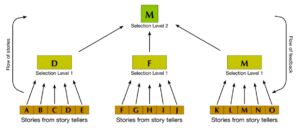Purpose: improve a project by focusing on the most meaningful changes the project will bring about
Who is it for: project managers
Technique: interviews, group discussion
Type of tool: implementation tool
Prior knowledge: none
Complexity: low
Time investment: months
Downloads
Links
Gerelateerde tools
What is Most Significant Change?
Most Significant Change (MSC) is a qualitative method designed to capture the most meaningful changes a project brings about in stories. Meaningful changes that occur and the shared criteria for why that change is seen as meaningful are systematically sought in a collaborative dialogue. This can provide guidance for the project during the project period and/or be useful for an assessment of the project’s success after completion. The method is sometimes referred to as ‘monitoring without indicators’, a way of making the non-tangible results count.
MSC relies heavily on the participation of participants and stakeholders in a project; it is they who jointly determine which stories are most meaningful to demonstrate the added value of the project. Discussing these is already valuable for forming a shared view of what the project should achieve and the criteria for what constitutes meaningful change. This process is also known as ‘dynamic values inquiry’. Using MSC during a project creates a shared focus on what is considered important, why it is considered important and what stories the project aims to deliver. As such, MSC focuses more on intermediate results than on the traditional output of a project, and also more on ‘learning during’ rather than ‘justifying afterwards’.
How do you use MSC?
The method especially comes into its own in situations where it is not possible, or very difficult, to precisely define the returns of a project in advance, or where those returns are very different for stakeholders, or where stakeholders do not initially agree on what the most important returns are. This lack of clarity can be paralysing; the MSC method can break through this impasse.
The method consists of several successive steps. In the first step, stakeholders are familiarised with the method and asked for their commitment to participate in the process. The second step is aimed at identifying the domains on which change monitoring is focused. This can be very broad, such as ‘people’s daily lives’, ‘collaboration’ or ‘organisational culture’ and is deliberately not defined narrowly as in the case of a performance indicator. Instead, it is about creating room for interpretation so that stakeholders can define for themselves what a change is and what is meaningful about it.
In the third step, stories are collected about meaningful changes from the target group and project staff closest to the target group. These stories are collected by asking a simple question along the lines of “in your view, what was the most important change that occurred in the last three months as a result of the project?”. Depending on the domains identified in the second step, this can be phrased more precisely, for example, “in your view, what was the most important change in daily life that occurred in the past three months as a result of the project?”.
In a fourth step, the best stories are selected. This is done by reading out the stories in selected groups of stakeholders and having them discuss among themselves the value of the change discussed and how meaningful it is. In larger projects, this can also be done by first doing this at ‘lower’ levels (such as in work packages) and then doing another selection round at a higher level in the project or programme and asking, “of all these meaningful changes, which one do you think is the most meaningful?”. This can even be done at the level of a steering committee or the project’s funding group. Each time a story is selected, the criteria used for the selection are noted and disseminated in the project so that the reasons why a story is considered important are shared. This creates criteria in the project for what is understood as meaningful; in turn, this can serve to guide one’s own contribution to the project.

A final step in the process is to use the selected stories to go back the source: the place the story relates to. The purpose of this is, on the one hand, to validate whether the story was told honestly and accurately, and on the other, to retrieve more detailed information needed for further knowledge sharing on why and how the change took place.
What is the origin of MSC?
De MSC method was originally developed by Rick Davies. During a large and complex development project in Bangladesh, he ran into the problem of monitoring and evaluating the project. The large scale of the project – tens of thousands of participants in hundreds of villages – and the open-ended design of the project made it difficult to use a traditional method. Getting everyone on board with a set of indicators was impossible, also because of the great diversity of activities and many conflicting interests. He first described the MSC methodology in his doctoral thesis (1996).



